JARS v61n1 - A Crop of Good Yellows from the ARS Seed Exchange
A Crop of Good Yellows from the ARS
Seed Exchange
Willis Harden
Commerce, Georgia
It didn't take many years after I started growing rhododendrons in 1956 to realize that most yellow varieties were more difficult in our climate in northeast Georgia than other colors. In the last few years we have improved our success in growing these rhododendrons with better growing methods, but during the '60s and '70s I was looking for varieties of yellow that were more easily grown. We had found by then that yellow varieties containing species of subsection Fortunea in their blood were usually successful and a number of good yellows of this type were popular and available. I had planted Rhododendron wardii several times to lose it and also a good many R. wardii hybrids that looked like R. wardii (rounded, shiny, or smallish leaves), so when purchasing hybrids I sought varieties with leathery, largish and more pointed leaves and larger growing plants. This resulted in improved success.
By the late 1970s I decided to try growing some seedlings with the goal of combining yellow flowers with vigorous plants. The late Cecil Smith was then contributing a lot of seeds to the ARS Seed Exchange, and I planted several of his crosses in the mid-'70s, all of them crosses between a yellow hybrid and a species or hybrid of subsection Fortunea. I hate to admit that I have lost the records of the exact crosses, but with Kathy VanVeen jogging my memory I am pretty sure that Dido Group and Jalisco Group were two of the hybrids involved and am also sure that R. decorum was used. Rhododendron decorum is also a parent of Dido Group, and R. fortunei ssp. discolor is a parent of Lady Bessborough Group, a parent of Jalisco Group (Lady Bessborough Group X Dido Group) so with the likelihood that R. fortunei ssp. discolor was used itself would make either it or R. decorum over half the makeup of most of the seedlings.
All the seedlings were planted in an area of the garden as a group, in a place not too visible. There they remained with little care or attention for several years. We don't maintain a nursery plot for seedlings but after they reach 3-gallon size plant them directly into the garden with the expectation that the majority of them will eventually be cut down. Other than this group most seedlings have been of no value and have been removed over time. These have been strikingly different. Although they involve several parents and are different in many ways, they are very good as a family (as opposed to a Group that would have the same parents). The best of them are as good, in my opinion, as the best named yellows in the garden. They all have yellow in their color to a varying degree, from golden through creamy shades and pink and yellow blends. Many of them have green throats, and a few of them are almost pure R. decorum in appearance. Whatever their individual color they all have a translucent clarity that denotes their descent from some of the choicest Oriental species.
I have not named any of them yet so have assigned them numbers. I describe the five that I think are best - all quite different.
CS1 . An upright plant that is well branched about 8 feet tall. The large flowers are golden yellow and well cover the plant. The trusses of about eight flowers are well filled but relaxed and the color is not marred by any striking markings. My ideal rhododendron is not "fancy" with flares or blotches, nor too conical or too large to be in proportion to the plant and leaves. The main object is that everything about the plant be in good proportion and the color of the flowers be clear. There is no other yellow in my experience that has a more intense color than this plant.
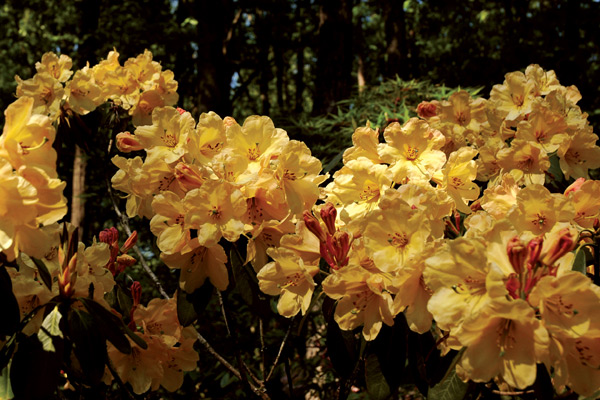
|
| CS1. |
CS2 . This plant is about the same size and shape as the first, the main difference between them being the flower color, which is here a soft shade of canary yellow. The large green stigma would point to R. calophytum in its ancestry, and I confessed in the beginning that I was unsure of exact parentage.
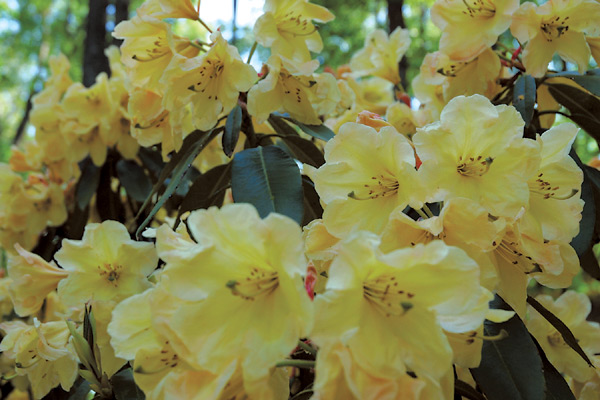
|
| CS2. |
CS3 . This is the most compact plant of the group, a 5-foot mound. It is also the heaviest bloomer and is smothered with blossoms an exceptional blend of yellow, pink and green, but from a distance they appear orange. There is a R. augustinii near this plant, and the blue and orange together make one of the nicest color combinations that I have seen.
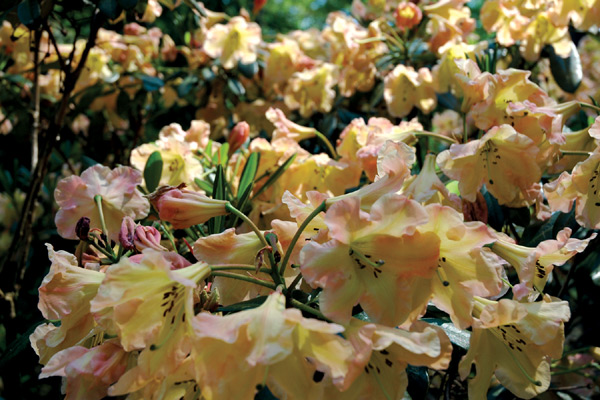
|
| CS3. |
CS4 . The cream flowers have green throats and are very large, in excess of 4 inches across. The upright and well-branched plant is the largest of the group at about 9 feet. This rhododendron becomes my favorite on a cloudy or drizzly day when it acquires a moonlight quality. Its coral beauty can be surpassed only by the others in bright sun.
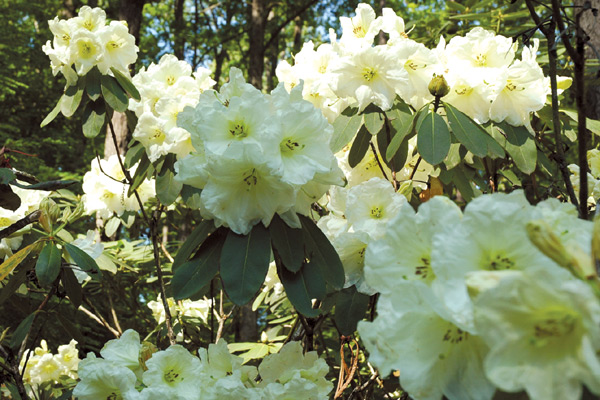
|
| CS4. |
CS5 . This is very different from the others, with flowers mostly pink but suffused cream and shading to green in the throat. The very large, six-flowered trusses allow the individual flowers to be appreciated. The open funnel-shaped form of the flowers with smooth surface and rounded lobes is my ideal.
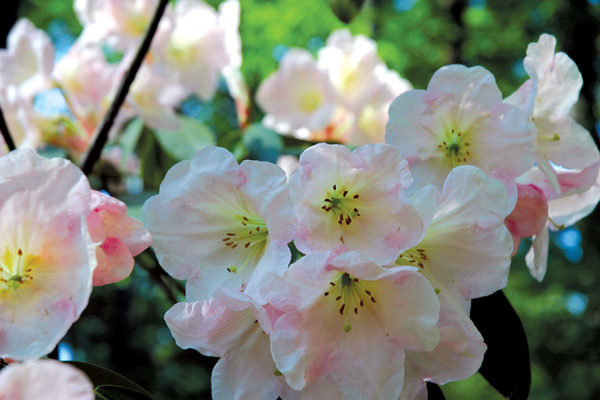
|
| CS5. |
Our growing methods may be of some interest to growers in similar climates to ours. We prefer less rather than more shade. Our woodland is mostly old oaks, and while it has added a lot of labor to the garden a couple of windstorms in the last few years have improved conditions a lot. All rhododendrons are planted in a plateau of pure pine bark. We are careful not to place any material over the root crown. A pine straw mulch discourages rodents as well as conserving moisture. Most importantly, we don't allow our rhododendrons to get a hint of drought. One to two inches of water per week guaranteed.
Willis Harden is a member of the Southeastern Chapter and owner of Homeplace Garden.
